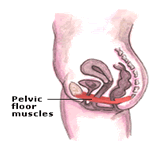General Information
Pelvic organ prolapse is a very common condition, particularly among older women. It’s estimated that half of women who have children will experience some form of prolapse in later life, but because many women don’t seek help from their doctor the actual number of women affected by prolapse is unknown. This leaflet explains the different types of prolapse that can occur and provides information about causes, diagnosis, treatment options and prevention as well as what you can do to help ease your symptoms.
 Normally, the pelvic organs are held in place by the pelvic floor muscles and supporting ligaments, but when the pelvic floor becomes stretched or weakened, they may become too slack to hold the organs in place. A number of different factors contribute to the weakening of pelvic muscles over time, but the two most significant factors are thought to be pregnancy and ageing.
Normally, the pelvic organs are held in place by the pelvic floor muscles and supporting ligaments, but when the pelvic floor becomes stretched or weakened, they may become too slack to hold the organs in place. A number of different factors contribute to the weakening of pelvic muscles over time, but the two most significant factors are thought to be pregnancy and ageing.
A bladder or urethra prolapse may cause incontinence (leaking urine), frequent or urgent need to urinate or difficulty urinating.
A prolapse of the small or large bowel (rectum) may cause constipation or difficulty defecating. Some women may need to insert a finger in their vagina and push the bowel back into place in order to empty their bowels.
Women with uterine prolapse may feel a dragging or heaviness in their pelvic area, often described as feeling ‘like my insides are falling out’. With severe prolapse, when the uterus is bulging out of the vagina, the skin may become irritated, raw and infected.
General Information
Pelvic organ prolapse is a very common condition, particularly among older women. It’s estimated that half of women who have children will experience some form of prolapse in later life, but because many women don’t seek help from their doctor the actual number of women affected by prolapse is unknown. This leaflet explains the different types of prolapse that can occur and provides information about causes, diagnosis, treatment options and prevention as well as what you can do to help ease your symptoms.
 Normally, the pelvic organs are held in place by the pelvic floor muscles and supporting ligaments, but when the pelvic floor becomes stretched or weakened, they may become too slack to hold the organs in place. A number of different factors contribute to the weakening of pelvic muscles over time, but the two most significant factors are thought to be pregnancy and ageing.
Normally, the pelvic organs are held in place by the pelvic floor muscles and supporting ligaments, but when the pelvic floor becomes stretched or weakened, they may become too slack to hold the organs in place. A number of different factors contribute to the weakening of pelvic muscles over time, but the two most significant factors are thought to be pregnancy and ageing.
A bladder or urethra prolapse may cause incontinence (leaking urine), frequent or urgent need to urinate or difficulty urinating.
A prolapse of the small or large bowel (rectum) may cause constipation or difficulty defecating. Some women may need to insert a finger in their vagina and push the bowel back into place in order to empty their bowels.
Women with uterine prolapse may feel a dragging or heaviness in their pelvic area, often described as feeling ‘like my insides are falling out’. With severe prolapse, when the uterus is bulging out of the vagina, the skin may become irritated, raw and infected.
Symptoms
Some women notice nothing at all, but others report these symptoms with pelvic organ prolapse:
- A feeling of pressure or fullness in the pelvic area
- A backache low in the back
- Painful intercourse
- A feeling that something is falling out of the vagina
- Urinary problems such as leaking of urine or a chronic urge to urinate
- Constipation
- Spotting or bleeding from the vagina

Treatment Options
There are a number of surgical and non-surgical options available to treat prolapse. The choice of treatment depends on a variety of factors such as the type of prolapse you have, the severity of your symptoms, your age and other health issues, whether or not you want to have children in the future, and your personal preference. Before you decide on a treatment, talk to your doctor about the risks, benefits and success rates of the treatments you are considering. This section describes the non-surgical treatments available for prolapse.
Most of the surgical treatments for prolapse aim to lift the prolapsed organ(s) back into place. Hysterectomy (for uterine prolapse) is the only treatment that removes the prolapsed organ altogether. The choice of surgery depends on the type of prolapse you have, your health, age, whether you want to keep your uterus or have children in the future, whether you are sexually active, the skills of your surgeon and your personal preference. If you’re not happy with the surgery that has been recommended, talk with your doctor about your concerns. If you are still not satisfied, or would like a second opinion, ask to be referred to another specialist.
Reduce Your Risk of Prolapse
There are a number of things you can do to reduce your risk of prolapse or help prevent a mild prolapse form getting worse:
- One of the most effective things you can do to reduce your risk of prolapse is to exercise your pelvic floor muscles. Doing regular pelvic floor exercises (also called Kegel exercises) throughout your adult life helps keep the muscles toned and strong. Most women do Kegel exercises when they are pregnant and for a few months after birth, but by making pelvic exercises part of your daily routine you can further reduce your risk of both prolapse and incontinence in later life.
- If you are significantly overweight, try to lose weight. This will remove some of the pressure from your pelvic area.
- If you smoke, try to cut down or stop, as this will help reduce strain from coughing.
- Don’t lift heavy objects. This can damage your pelvic muscles.
- Eat a high fibre diet (fresh fruits, vegetables, bran) to help prevent constipation and reduce straining.
- If you are menopausal or post-menopausal, some doctors may suggest you use hormone replacement therapy to protect against prolapse or prevent an existing prolapse from getting worse, but there is little scientific evidence to support the claim that HRT prevents prolapse. Before you make a decision about whether or not to use HRT, discuss the risks and benefits with your doctor.
